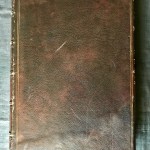The Book of Common Prayer, and Administration of the Sacraments, and other Rites and Ceremonies of the Church, According to the Use of the Church of England, Together with the Psalter or Psalms of David,…And the Form & Manner of Making, Ordaining, & Consecrating of Bishops, Priests and Deacons [with] The Whole Book of the Psalms
London, Printed by John Baskett, …, And by the Assigns of Thomas Newcomb, and Henry Mills, …, 1715; London, Printed by John March, …,1729.
£3500
Folio. No pagination and foliation; ff. ii, a-c 4 A-Z4 Aa-Zz4 Aaa4 A-O2 . Pages ruled in red throughout, double-column text. Roman and Italic letter, sporadic black letter. Title in red and black, beautiful floriated and historiated woodcut initials from various sets and of different sizes, and capital spaces with guide-letters; large head- and tail-pieces, signed engraved frontispiece of a church rotunda with inscription “Domus Orationis” and several figures (originally designed by John Baptist Caespers and realised by David Loggan). Tables containing the calendar of movable and immovable feasts, in red and black ink, and prayer times. Extensive paper repair to C2 not affecting the text and to lower blank margin of C3 and 4 (The Litany). Bound in late C19th brown morocco with double fillet gilt along cover edges and to turn-ins. Giltruled spine in six compartments with raised bands and gilt-stamped title. Large gilt leather cuttings, probably from the original calf binding, attached to the marble pastedowns, showing ownership of the barrister and treasurer Sir George Cooke (1676-1741): “GEORGIUS COOKE MILES THESAURARIUS MDCCXXIX” with the emblem of the Inner Temple (Pegasus on an armorial shield) underneath. An attractive and outstanding copy.
Born of Thomas Cranmer’s desire for liturgical texts upon which all of Europe’s Protestant, English-speaking churches could agree, the beautiful and dignified language of the Book of Common Prayer, first issued in 1549, has considerably influenced not only ecclesiastical practice, but has served “as a source of spiritual inspiration for most Englishmen second only to the Bible” (PMM 75).





